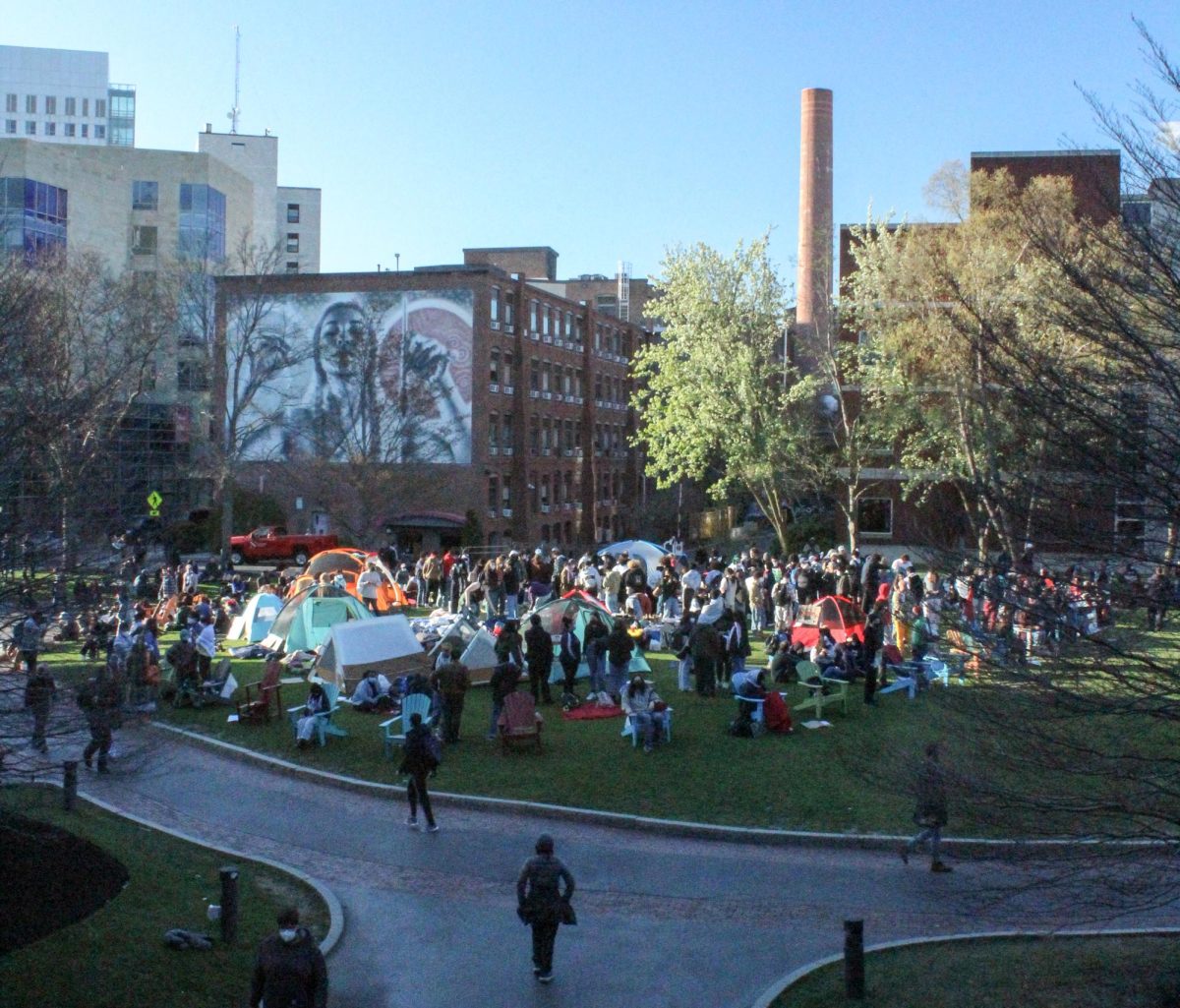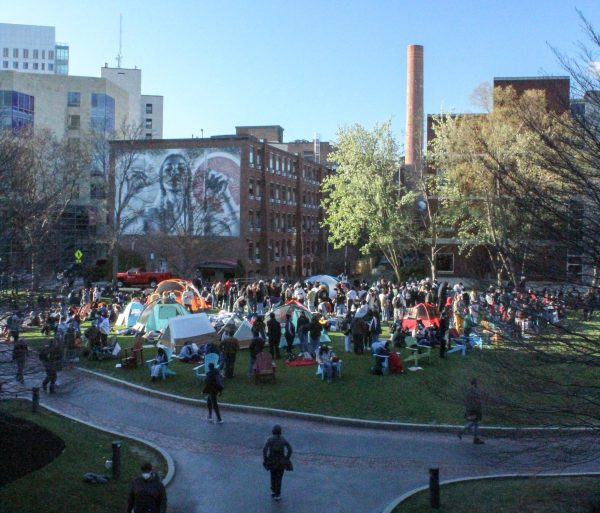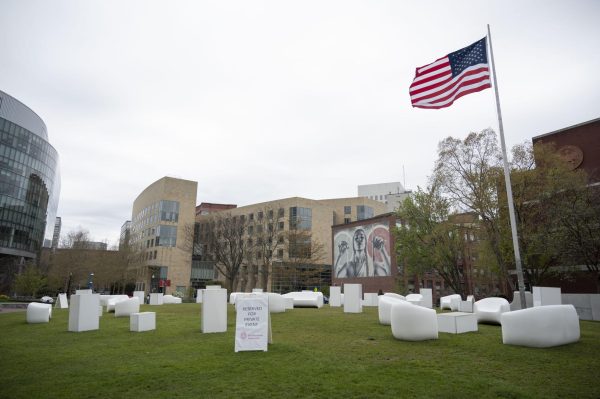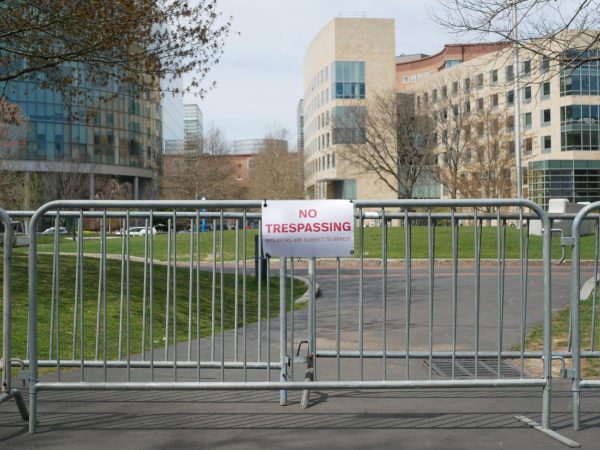Local artist creates a game about gentrification
November 12, 2018
“Congratulations, you get to stay in an Airbnb in Gentriville, USA. Move on over to the other side of the board,” said Tory Bullock, director of the Gentrification Game. Suddenly, police sirens blare over the speakers. “Oh, looks like the police have been called. That sucks, man! You lose two turns.”
Bullock, 25, is a performance artist with a flair for the dramatic. When he’s not tormenting players, he runs theater and improv workshops. Today, however, dressed in white painter’s coveralls, Bullock is the director of the Gentrification Game, a gamified abstraction of the frustration faced by the victims of gentrification – and the ignorant bliss of the gentrifiers.
The Gentrification Game is played on a life-size monopoly board. Cardboard buildings line two sides of the board, one with buildings common in not-yet-gentrified neighborhoods – a bodega, a check casher, a liquor store — the other with gentrified buildings, underneath a sign reading “Gentriville, USA.”
Players take turns rolling a giant die to determine where they’ll move until they eventually land on a special space. Each special space has about ten potential outcomes, which Bullock picks based on how much he wants to frustrate, or assist, players. Bullock also adds music and sound effects to the game using the Youtube and iTunes apps on his phone, or “guerrilla-style” as he describes it.
The game’s true conceit is revealed when a player steps on the money space. Bullock then instructs them to move over to the Gentriville of the board, and offers them a chair to sit down on. The player in Gentriville casually scoots along their side of the board until the game ends, occasionally being asked to decide whether or not they’ll allow other players to proceed. Their victory is guaranteed; the only things they control are how long that takes and whether or not they want to allow the other players to continue.
The goal of the game is to highlight the inequality between the victims and the beneficiaries of gentrification, Bullock said. Bullock manipulates the game to maximize frustration for the former while granting considerable leeway to the latter.
“A lot of the reactions are frustration like, ‘Uh, this game is rigged, no matter how many steps I take I have to go all the way back to the beginning.’ That’s a very common one,” said Veronica Wells, 30, Bullock’s videographer. “Another one that’s very common is just people feeling like they can feel what displacement can do to somebody and how that can affect people in the community, and feeling frustrated and almost guilty and sad.”
Bullock got the idea for the Gentrification Game from a video he made in January in which he complained about the absurdity of building unaffordable luxury condos in a housing shortage.. The video went “mega viral,” as Bullock described it, receiving more than 500,000 views by November 2018. Bullock wanted to take the idea further.
“But I didn’t want to do the same thing again. I wanted to do it in a way that was interactive,” Bullock said. “There’s nothing more interactive and fun than a board game, so I decided to take that idea and started working on it.”
A group called Designing for Social Intervention, or ds4si, funded the game, held in a former bank in Dorchester. Ds4si also hosts other pop-up art projects at the bank, including jazz performances and a bookstore.
Northeastern graduate students Erin Breneman and Lauren McMullen were exploring Dorchester for a class when they came across a poster for the game. Intrigued, they decided to take part.
“I thought it was really cool and I think that he’s been thinking a lot about this. It’s clear that he’s trying to create a dynamic between players that shows how much this affects people on the other side of the game,” McMullen said. Her colleague Brenneman agreed.
“The music is awesome, it’s totally a really fun time,” Breneman said. “He did a great job. It’s a great experience and I really like his energy.”
As Brenemen sat in Gentriville, McMullen landed on the challenge card, prompting the final challenge of the game. Bullock handed each player a sheet of paper and a marker and instructed them to draw any building they’d like to see in their neighborhood.
Brenneman drew a simple house, while McMullen left her sheet empty. Her marker was dry.
“Oh, you didn’t have the right resources to build this?” Bullock said. “That sounds like a ‘you’ problem.”

















